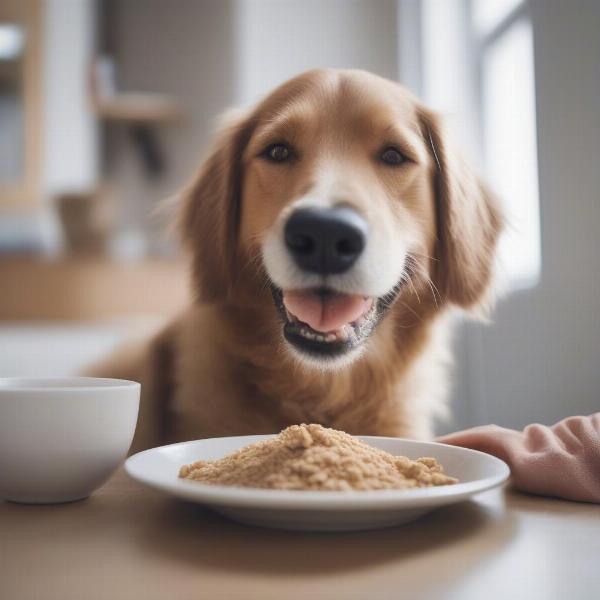Weetabix for dogs glands is a topic that often pops up in online dog forums and discussions. Many owners wonder if this popular breakfast cereal can truly help with their dog’s anal gland issues. This article will delve into the science behind this home remedy, explore whether Weetabix is a suitable solution for anal gland problems, and discuss alternative approaches to managing this sometimes smelly issue.
Can Weetabix Really Help with Dog Anal Gland Problems?
The idea behind using Weetabix for dog anal glands is that the high fiber content will add bulk to the stool, promoting larger, firmer bowel movements. This, in turn, is thought to put pressure on the anal glands during defecation, encouraging them to empty naturally. While this logic seems sound, there’s limited scientific evidence to support the effectiveness of Weetabix specifically for this purpose.  Dog eating weetabix for anal glands
Dog eating weetabix for anal glands
However, ensuring your dog has adequate fiber in their diet is undeniably important for overall digestive health, including regular bowel movements. If your dog suffers from chronic loose stools, this can contribute to impacted anal glands. So, while Weetabix might not be a miracle cure, adding fiber to your dog’s diet can be beneficial.
Alternative Solutions for Anal Gland Issues in Dogs
If your dog is experiencing anal gland problems, it’s crucial to consult with a veterinarian. They can determine the underlying cause of the issue and recommend the most appropriate course of action. Some common solutions include:
- Manual expression of the anal glands: This is a procedure performed by a vet or groomer where the glands are manually emptied.
- Dietary changes: Increasing fiber intake, as mentioned earlier, can sometimes help. Your vet may recommend specific high-fiber dog foods or supplements.
- Medications: In some cases, antibiotics or anti-inflammatory medications may be necessary to treat infections or inflammation of the anal glands.
- Surgical removal: In severe or recurring cases, surgical removal of the anal glands may be the best option.
Understanding Dog Anal Gland Problems
Dog anal glands are small sacs located on either side of the anus that produce a foul-smelling fluid. Normally, these glands empty naturally during defecation. However, sometimes they can become impacted or infected, leading to discomfort and a variety of symptoms. These can include:
- Scooting or dragging their bottom along the ground
- Excessive licking or biting at the anal area
- A foul odor emanating from the rear end
- Pain or discomfort when defecating
Preventing Anal Gland Problems in Dogs
While not all anal gland problems are preventable, there are steps you can take to reduce the risk:
- Maintain a healthy weight: Obesity can contribute to anal gland issues, so ensure your dog is at a healthy weight through proper diet and exercise.
- Provide a balanced diet: A diet rich in fiber can help promote regular bowel movements and prevent impaction.
- Regular vet checkups: Regular veterinary exams can help identify and address potential anal gland problems early on.
Is Weetabix Safe for Dogs?
While a small amount of Weetabix is unlikely to cause harm, it’s not a necessary part of a dog’s diet. Dogs require a balanced diet specifically formulated for their nutritional needs. Feeding them excessive amounts of human food, even seemingly harmless things like Weetabix, can lead to nutritional imbalances or digestive upset. Always consult your veterinarian before adding any new foods to your dog’s diet, including Weetabix.
Conclusion
While the effectiveness of Weetabix for dog anal gland problems is debatable, ensuring your dog has a balanced diet with adequate fiber is essential for their overall digestive health. If you suspect your dog is experiencing anal gland issues, consult your veterinarian for a proper diagnosis and treatment plan. Don’t rely on home remedies without professional guidance.
FAQ
-
Can I give my dog Weetabix every day? It’s best to consult with your veterinarian before adding any new foods to your dog’s diet, including Weetabix. While a small amount is unlikely to cause harm, it’s not a necessary part of a dog’s diet.
-
What are the signs of impacted anal glands in dogs? Signs include scooting, excessive licking of the anal area, a foul odor, and difficulty defecating.
-
How can I prevent anal gland problems in my dog? Maintaining a healthy weight, providing a balanced diet, and regular vet checkups can help reduce the risk.
-
Is it safe to express my dog’s anal glands myself? It’s generally recommended to have a veterinarian or groomer express your dog’s anal glands, as improper technique can cause injury.
-
What should I do if my dog’s anal glands keep getting impacted? Consult with your veterinarian. They may recommend dietary changes, medication, or in severe cases, surgical removal of the glands.
-
Are there any alternative high-fiber foods for dogs? Yes, there are many high-fiber dog foods and supplements available. Your vet can recommend options suitable for your dog.
-
Can stress cause anal gland problems in dogs? While not a direct cause, stress can sometimes exacerbate existing health issues, including anal gland problems.
ILM Dog is a leading international dog website dedicated to providing expert advice on all aspects of dog care and wellbeing. From breed selection and puppy care to senior dog health and training tips, we offer a wealth of reliable information for dog owners worldwide. We specialize in helping you navigate the joys and challenges of dog ownership, providing expert guidance on everything from nutrition and grooming to behavior and health. Contact us for professional advice tailored to your dog’s individual needs! Email: [email protected] Phone: +44 20-3965-8624. Visit ILM Dog for more valuable resources and expert insights.